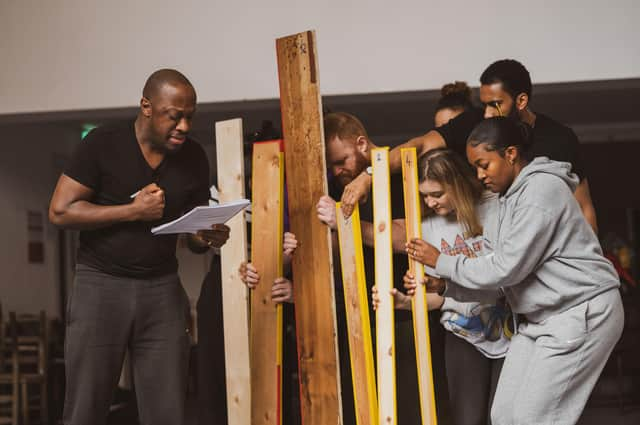'It's about the power of the human spirit' - Giles Terera on The Meaning of Zong


Such was the wealth of material Giles Terera came across when he started work on The Meaning of Zong, he thought he might have two plays on his hands. The first would be about the slave ship Zong which, in 1781, found itself adrift in the middle of the Atlantic. Its malnourished human cargo was getting increasingly ill. As crew and captives alike began to die, Captain Luke Collingwood gave the order to throw any unwell slaves into the ocean. In the following days, the crew condemned 132 people to drown. A further ten threw themselves overboard, a gesture Collingwood would call an "act of defiance".
"It is an extraordinary voyage," says Terera, winner of the 2018 Olivier Award for Best Actor in a Musical for his role as Aaron Burr in Hamilton. "From the beginning, it is fraught with craziness and mishaps. The ship is built by the Dutch, the British win it, then it sits on the west coast of Africa for six months before a Liverpool trader buys it. They get the name wrong – it was a Dutch ship called the Zorg – they cobble together a crew, some of whom are Dutch, some of whom are British. So from the beginning, the whole thing is a mess."
Advertisement
Hide AdThe incident became the subject of a court case after the ship's owner, William Gregson, made an insurance claim for the loss of his slaves. He was initially successful, but when the insurers appealed, the judge overturned the ruling. He condemned the ship's bad management and inadequate water allowance. This was a lucrative business and the owner had crammed 470 slaves onboard, overloading the ship in the name of profit.
Consulting documents including a transcript of the appeal hearing, Terera spent six months piecing together as full a story as he could. "In the transcript, there is information about two of the Africans who were on the ship," he says. "One was thrown into the sea and managed to hang onto a rope and pull themselves back onto the ship. The other spoke on behalf of the rest of the Africans to the crew and tried to reason with them. Even though it wasn't a lot of information, it was enough to start building a character."
The case became a focal point for the emerging abolitionist movement in Britain, in particular two men: Granville Sharp and Olaudah Equiano. As a prominent campaigner, Sharp was the son of an archdeacon and had taught himself Greek and Hebrew. Equiano, on the other hand, had an altogether less conventional background.
Born in what is now southern Nigeria, he was caught by slave traders at the age of 11 and sold to owners in Virginia and Pennsylvania, as well as to a British naval officer who renamed him Gustavus Vassa. He took him on his voyages around the world and had him educated.
At 32, after having two more owners, Equiano bought his freedom and settled in the UK. Here, he petitioned the government to end the slave trade and, in 1789, published his autobiography. By the time of his death in 1797, he was married with two children.
Here, thought Terera, was material enough for a second play. "When they make a movie about his life, it's going to be amazing," he says. "He goes on Arctic expeditions and teaches himself to play the cello."
Advertisement
Hide AdEquiano's only connection with the Zong was reading about it in the newspaper and bringing the story to Sharp's attention. Terera's challenge as a dramatist was to marry the two. "I heard this story and immediately I could draw a line back 200 years to when Granville Sharp opens his door and Olaudah Equiano is standing there and he says, 'I need to tell you about this thing that has happened.' I thought, 'What if the Zong story is linked to his awakening?' It could come at the moment he's making the shift between the young boy who grew up in Africa and the man he grew up to be in London. When I had that idea, everything fell into place."
Terera himself plays Equiano in a production he has co-directed with Tom Morris, of War Horse fame, for the Bristol Old Vic in association with Edinburgh's Royal Lyceum. Starring opposite him as Sharp is Scottish actor Paul Higgins.
Advertisement
Hide AdDespite the weighty subject matter, the tone is celebratory. With Ivory Coast multi-instrumentalist Sidiki Dembele on stage throughout, the production aims to capture the life force that drove that slave to grab a rope and haul himself back onto the ship.
"It's not a story about trauma," says Terera. "It's more of a story about triumph. It's also about the brilliance, ingenuity and strength of my people. If you look at modern pop culture in America and the West, it all comes out of the African community; whether it's jazz, whether it's blues, which becomes rock 'n' roll, or whether it's hip hop. In spite of 400 years of all of that [trauma], you've still got the alchemy of making something the world can enjoy. I was interested in the alchemic thing of taking a situation and turning into something life-affirming and joyous. It's about the power of the human spirit and how much an individual can do to affect their circumstances."
The Meaning of Zong, Royal Lyceum, Edinburgh, 13–23 April, https://lyceum.org.uk/
A message from the Editor
Thank you for reading this article. We're more reliant on your support than ever as the shift in consumer habits brought about by coronavirus impacts our advertisers.
If you haven't already, please consider supporting our trusted, fact-checked journalism by taking out a digital subscription at https://www.scotsman.com/subscriptions